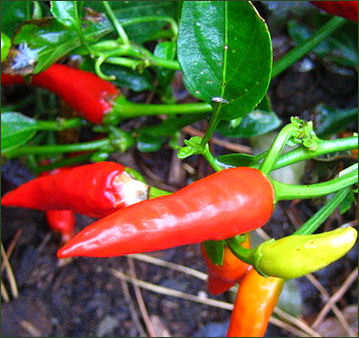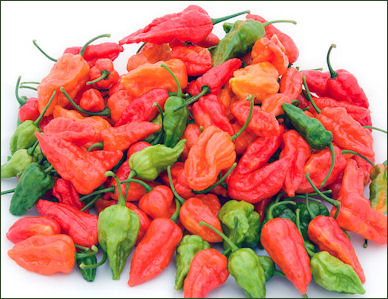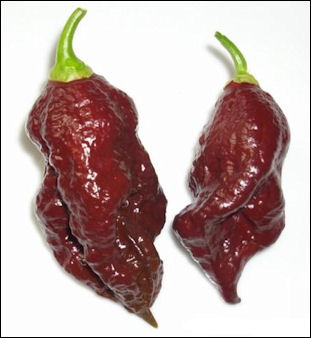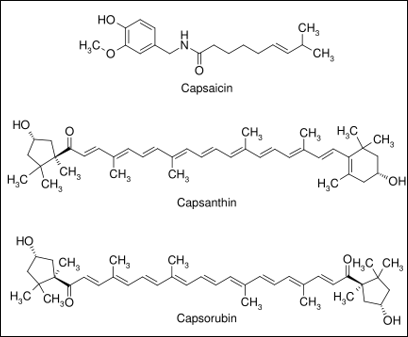PEPPER AND PEPPERS

Charleston hot peppers Black pepper comes from peppercorns. It is used as a seasoning and belongs to the “Piper” genus. Hot peppers belong to the “Capsicum” genus. The two are unrelated an the confusion over their names can be traced to Columbus (also the sources of the confusion of American Indians and Indians from Indian) who called the New World Capsicums peppers because he believed he was in the spice growing region of India. [Source: Jim Robbins, Smithsonian]
Other non-capsicum flavorings also referred to as peppers are pink peppercorns, Sichuan pepper from China and malegueta peppers from Brazil and Africa.
Hot peppers and bell peppers belong to the “ Capsicum” genus. They originate from the New World but now are found almost everywhere. There are dozens of different kinds of peppers and they come in all shapes and colors, from purple to orange to deep red.
Peppers are the podlike fruits of leafy plants that grows two to four feet high and have white flowers. Botanists can't make up their mind whether they are a fruit or berry. No matter what color they are when they ripen all peppers come from pods that are green before they ripen.
The nightshade family includes tomatoes, potatoes, eggplants and variety of hot and sweet peppers and the deadly belladonna. Most plants in this family are rich in potent intoxicants and psychoactive chemical substances called tropane alkaloids, some of which have hallucinogenic and even reputed mystical qualities. In Europe, for example, belladonna (atropa), henbane (hyocyamus) and mandrake (mandragora) have long been associated with magic and witchcraft.
There are two basic types of capsicums: 1) mild or sweet varieties; and 2) hot and pungent varieties. Most mild varieties are relatively large. Chilis, pimentos, paprika and cayenne are all varieties of hot pepper. Sri Lanka, Southeast Asia and Java have traditionally been the sources of peppercorns for pepper.
Websites and Resources on Hot Peppers: Wikipedia article on Chilie Peppers Wikipedia ; ChiliFarm chillifarm.com ; Chileman thechileman.org ; Chile Seeds chileseeds.co.uk ; Wikipedia article on the world’s hottest pepper Wikipedia ; Chili Pepper Institute: www.chilepepperinstitute.org ; Book: “ The Fiery Cuisines” by Dave DeWitt and Nancy Gerlach.
Websites and Resources on Spcies: Different Spices spice-trade.com/types-of-spices ; Spice Plants uni-graz.at/~katzer ; Spice Farming spices.indianetzone.com/1/spice_farming.htm ; History of Spice Trade celtnet.org.uk/recipes/spice_trade ; History Spices, Spices Indian Trade Zone spices.indianetzone.com/ ; Encyclopedia of Spices theepicentre.com/Spices ; McCormik Spice Encyclopedia mccormick.com ; Wikipedia article on Spices Wikipedia ; Wikipedia article on the Spice Trade Wikipedia ; Book: “ Spice” by Jack Turner (Knopf, 2004)
World’s Top Producing Countries of Dry Chillies and Peppers
Green peppers are to unprepared pepper fruit. Drying peppers is an excellent of preserving them. Dried peppers have their moisture removed, which concentrates the flavor and heat of the peppers. Dried peppers can be ground into powders, or rehydrated to use in sauces, soups, stews, and chilies.

-Banana peppersWorld’s Top Producers of Dry Chillies and Peppers (2020): 1) India: 1702000 tonnes; 2) Thailand: 322886 tonnes; 3) China: 307593 tonnes; 4) Ethiopia: 295981 tonnes; 5) Bangladesh: 157607 tonnes; 6) Pakistan: 141541 tonnes; 7) Myanmar: 140980 tonnes; 8) Côte d'Ivoire: 127642 tonnes; 9) Benin: 108934 tonnes; 10) Ghana: 108231 tonnes; 11) Vietnam: 97118 tonnes; 12) Nepal: 68025 tonnes; 13) Nigeria: 62556 tonnes; 14) Mexico: 60708 tonnes; 15) Egypt: 60194 tonnes; 16) Peru: 42471 tonnes; 17) Cameroon: 37715 tonnes; 18) Democratic Republic of the Congo: 36931 tonnes; 19) Morocco: 26961 tonnes; 20) Bosnia and Herzegovina: 25759 tonnes. [Source: FAOSTAT, Food and Agriculture Organization (U.N.), fao.org. A tonne (or metric ton) is a metric unit of mass equivalent to 1,000 kilograms (kgs) or 2,204.6 pounds (lbs). A ton is an imperial unit of mass equivalent to 1,016.047 kg or 2,240 lbs.]
World’s Top Producers (in terms of value) of Dry Chillies and Peppers (2019): 1) India: Int.$2530372,000 ; 2) Thailand: Int.$505351,000 ; 3) China: Int.$473323,000 ; 4) Ethiopia: Int.$454560,000 ; 5) Côte d'Ivoire: Int.$255154,000 ; 6) Bangladesh: Int.$216995,000 ; 7) Myanmar: Int.$199047,000 ; 8) Ghana: Int.$183341,000 ; 9) Vietnam: Int.$147737,000 ; 10) Pakistan: Int.$147582,000 ; 11) Nigeria: Int.$104404,000 ; 12) Nepal: Int.$97509,000 ; 13) Egypt: Int.$90398,000 ; 14) Mexico: Int.$88129,000 ; 15) Cameroon: Int.$71887,000 ; 16) Benin: Int.$66947,000 ; 17) Democratic Republic of the Congo: Int.$54810,000 ; 18) Uzbekistan: Int.$45431,000 ; 19) Morocco: Int.$43805,000 ; [An international dollar (Int.$) buys a comparable amount of goods in the cited country that a U.S. dollar would buy in the United States.]
Top Producing Countries of Dry Chilies and Peppers: in 2008 (Production, $1000; Production, metric tons. FAO): 1) India, 3771670 , 1269850; 2) China, 748482 , 252000; 3) Peru, 490078 , 165000; 4) Thailand, 479697 , 161505; 5) Pakistan, 386122 , 130000; 6) Bangladesh, 349782 , 117765; 7) Ethiopia, 341569 , 115000; 8) Ghana, 240583 , 81000; 9) Viet Nam, 233158 , 78500; 10) Myanmar, 210882 , 71000; 11) Mexico, 178210 , 60000; 12) Nigeria, 148508 , 50000; 13) Egypt, 135439 , 45600; 14) Democratic Republic of the Congo, 100985 , 34000; 15) Romania, 98015 , 33000; 16) Bosnia and Herzegovina, 89105 , 30000; 17) Côte d'Ivoire, 59403 , 20000; 17) Turkey, 59403 , 20000; 19) Nepal, 48597 , 16362; 20) Benin, 44552 , 15000;
World’s Top Producing Countries of Green Chillies and Peppers

Chili peppers World’s Top Producers of Green Chillies and Peppers (2020): 1) China: 16650855 tonnes; 2) Mexico: 2818443 tonnes; 3) Indonesia: 2772594 tonnes; 4) Turkey: 2636905 tonnes; 5) Spain: 1472850 tonnes; 6) Egypt: 1055605 tonnes; 7) Nigeria: 762174 tonnes; 8) Algeria: 717659 tonnes; 9) United States: 715220 tonnes; 10) Netherlands: 430000 tonnes; 11) Tunisia: 420000 tonnes; 12) Italy: 247620 tonnes; 13) South Korea: 243424 tonnes; 14) Niger: 239556 tonnes; 15) Kazakhstan: 227548 tonnes; 16) North Macedonia: 204919 tonnes; 17) Ukraine: 181290 tonnes; 18) Peru: 176162 tonnes; 19) Greece: 164290 tonnes; 20) Poland: 158800 tonnes
World’s Top Producers (in terms of value) of Green Chillies and Peppers (2019): 1) China: Int.$12736536,000 ; 2) Mexico: Int.$2173251,000 ; 3) Turkey: Int.$1762139,000 ; 4) Indonesia: Int.$1737284,000 ; 5) Spain: Int.$941165,000 ; 6) Egypt: Int.$512932,000 ; 7) Nigeria: Int.$505431,000 ; 8) Algeria: Int.$453119,000 ; 9) United States: Int.$419438,000 ; 10) Tunisia: Int.$297730,000 ; 11) Netherlands: Int.$251670,000 ; 12) South Korea: Int.$182437,000 ; 13) Niger: Int.$175105,000 ; 14) Italy: Int.$167538,000 ; 15) Morocco: Int.$166175,000 ; 16) Kazakhstan: Int.$143559,000 ; 17) North Macedonia: Int.$124461,000 ; 18) Ukraine: Int.$115990,000 ; 19) Israel: Int.$114990,000 ; [An international dollar (Int.$) buys a comparable amount of goods in the cited country that a U.S. dollar would buy in the United States.]
Top Producing Countries of Green Chilies and Peppers in 2008 (Production, $1000; Production, metric tons , FAO): 1) China, 4925876 , 14274178; 2) Mexico, 709148 , 2054968; 3) Turkey, 619842 , 1796177; 4) Indonesia, 376877 , 1092115; 5) Spain, 342398 , 992200; 6) United States of America, 313966 , 909810; 7) Nigeria, 250190 , 725000; 8) Egypt, 242739 , 703408; 9) Republic of Korea, 133122 , 385763; 10) Netherlands, 113879 , 330000; 11) Italy, 112405 , 325727; 12) Tunisia, 100421 , 291000; 13) Algeria, 96762 , 280397; 14) Ghana, 96280 , 279000; 15) Romania, 82366 , 238682; 16) Morocco, 80136 , 232220; 17) Ethiopia, 63745 , 180; 18) Israel, 61571 , 178423; 19) Hungary, 57484 , 166579; 20) Venezuela (Bolivarian Republic of), 52532 , 152229;
History of Peppers

Cherry peppers
People have been spicing up food with chilies for at least 8,000 years, likely adding them to potatoes, grain and corn, says Linda Perry an archeobotonist at Smithsonian Museum of Natural History. She has found traces of chilies in ancient milling stones and cooking pots from the Bahamas to southern Peru. From research done at various sites she has conclude that early Americans began cultivating chilies about 6,000 years ago. Perry told Smithsonian magazine, “Chiles were domesticate early and spread very quickly because people like them. Do you want a pig pot of yams or a pot of yams with chilies.”
Wild chilies probably originated in Bolivia and were carried into Central America by birds. They were cultivated as early as 5000 to 3500 B.C. The Cora Indians believed that the first peppers were created from the testes of the first man and dropped onto the plates of startled guests at a dinner party. In the Inca creation myth, chilies were also one of the four brothers that begat mankind.
A study in the journal Science in the late 2000s revealed that chilies many be the oldest seasoning use in the Americas. Residue was found in cooking tools at a 6,100-year-old Ecuadorian site. Researchers Jennifer Billing and Paul Sherman at Cornell have suggested people first began using chilies because they prevented food spoilage. Others have pointed to its medicinal qualities: the ancient Mayans used chilies in treatments for infected wounds, gastrointestinal problems an earaches. Peppers were eaten and revered by both the Mayas and Aztecs. Montezuma used drink a chocolate and pepper brew for breakfast everyday.

hot pepper sauce By the time Europeans arrived they were cultivated all over the Americas and the Caribbean. Columbus encountered them in 1492 being cultivate by the Arawak Indians on Hispaniola. He mistook them for "pepper" — an unrelated spice from Asia — the same way he mistook native Americans for "Indians" which is why we now have "bell peppers," "chile peppers" and "hot peppers."
Columbus wrote: “The land was found to produce much “aji”, which is the pepper of the inhabitants and more valuable than the common sort [black pepper]. They deem it very wholesome and eat nothing without it.” Columbus introduced chilies to Spain, where they initially did not much of an impact. A 16th century Jesuit priest wrote, "the use of peppers is prejudicial to the health of the young fools, chiefly to the soule, for that it provokes, to lust."
The Portuguese encountered chilies at their trading posts in Pernambuco, Brazil. They introduced them along with tobacco and cotton to Africa. Not long after that they were cultivated in India, Japan and China.
Hot Peppers
The active ingredient in hot peppers and chilies is an alkaloid called capsaicin. It is produced by the glands of the pepper's placenta, the part of the plant right below the stem where the seeds are. The placenta is 16 times hotter than the rest of the pepper.
Some species of pepper yield a crop every month for three months, suddenly stop producing and then resumes the same pattern after six months. Only red peppers and some jalapeños can be picked by machine; the rest are picked by hand. In many countries the peppers are laid on blankets and dried in the sun and then are hung in circles that resemble Christmas wreaths. The plants will last until a killer frost wipes them out. In chili processing plants, outsiders can often only stay a few minutes because there eyes tear up and their noses run.
Hot Pepper Consumption
People in some countries eat chilies to keep cool in a hot climate. The chilies cause them to sweat and the evaporation of the sweat from the skin has a cooling effect. No one is sure why peppers produce capsaicin. Some biologist speculate that it was probably to keep certain animals from eating the plant. Rabbits, for example, don't like chilies. Their digestive system destroys the chile's seeds, while those of birds that eat peppers don't.
If you bite into a particular explosive hot chile one of the worst things you can do is drink water. Think about it. Your mouth is already filled with saliva and adding water only spreads the hotness around. What you need is food that absorbs the hotness. Starches like potatoes and the corn in tortillas are good as well as the sugar and milk in ice cream.
Capsaicin

Naga jolokia Many spicy foods get their spiciness from capsaicin, a powerful chemical capable of making the tongue burn and the eyes water and the run. It works by stimulating neural sensors in the tongue and skin that also detect rising temperatures. Enough of it will cause adrenalin to flow and the heart to beat faster.
Capsaicin works by triggering a unique protein in the nerve cells that activates an ion channel that sends a quick pain message to the brain. The same receptor is believed to be used to respond to hot items or scalding water.
Scoville heat units (SHU) are used to rate a pepper’s heat potential. Named after the American chemist Wilbur Scoville, the SHU rating system measures amounts of capsaicin, with a range 0 SHU for a sweet bell pepper to 1 million SHU for the bhut jolokia and naga jolokia from India, the hottest peppers so far tested. Jalepeños 5000 and habaneras register as high 300,000, while pure capsaicin is 15 million. The system was devised in 1912 and measures the amount in sugar water needed to dilute the pepper to produce no sensation of spiciness.
Capsaicin is used as a deterrent for thumb sucking, applied to the neck wool of sheep to discourage predators and is key ingredient in Grizzly bear repellants. mace used in riot control and sprays used by the FBI and police that are 1,200 more powerful than tear gas. The alkaloid in these sprays forces the eyes to shut and the victim to have respiratory spasm which don't wear off for a half an hour or more.
Pepper Sources and Why Peppers are Hot
The source of the world’s hottest and earliest peppers appears to be the mountains and deserts of Bolivia. Dozens of wild species are found there and these are thought to be ancestors of peppers widely consumed today. Joshua Tewksbury, an ecologist at the University of Washington, has conducted several searches for wild chilies in Amboro National Park in Bolivia to find out more about their origin and what purpose their hotness serves. [Source: Brendan Borrell, Smithsonian magazine, April 2009]
Like other fruits, chilies need birds, insects and other animals to help deposit the seeds but not all animals are helpful. Some crush the seeds and make them unable to be germinated. Many plants produce toxic or foul-tasting chemicals ro deter seed predators. It is thought that capsaicin may deter bugs that carry a fungus or seed predators such as rodents. In North America the rodent theory makes sense. Many homeowners add capsaicin to their bird seed to deter squirrels but not birds. In Bolivia, where many peppers thrive, that theory doesn’t make as much sense because chilies are not threatened by rodents.

Bhut jolokia Tewksbury and other researchers have found a fungus in Bolivia that is particularly aggressive towards chilies. The also found the more capsaicin a pepper had the less likely it was to be infected by the fungus. Tewksbury told Smithsonian magazine, “Capsaicin has demonstrated the incredible elegance of evolution. Once in a while, the complex, often conflicting demands that natural selection places on complex traits results in a truly elegant solution.”
The hottest peppers are members of the jolokia family. Their heat is over five times hotter than the peppers used to make Tabasco sauce. On the outside these peppers seem harmless enough as their skin offers protection from the capsaicin inside but once opened the seeds and flesh are potent enough to burn hands that hold them.
The habanera (habeño) chile of the Yucatan, Mexico is one the hottest peppers in the world. Hardcore Chileheads eat them with lime and salt and describe the experience as "culinary skydiving" and the peppers themselves as "gringo killers." The Serrono is the hottest of all common chiles.
Hottest Peppers
Other kinds of hot peppers include: the Cuban “aj lengua de párjaro” “chile tecpin” ("bird's tongue chile”); the Mexican chile “ tecpin” ("flea chile”); the Haitian “ petit malice” ("little prank"); the Brazilian “ mata-frade” ("friar killer"); East African “ pilipili” ("chile that makes you say 'ho-ho'"); the Cuban “ ají escurre-huéspedes “ ("chile that makes guests sneak away"): and the Thai “ prik khi nu “ ("rat-dropping chile").
The jalapeño is named for Jalapa, Veracruz and has been described as "best known pepper of them all." Red pepper and cayenne are the ground dried pods of some larger varieties of Capsicum. Tabasco sauce is made from the small tabasco pepper. Other hot sauces are made by fermenting a mash of ground cayenne peppers, salt and water.
Kinds of Hot Peppers
Paprika is mild, slightly sweet style of hot pepper developed in Spain and Hungary and reportedly introduced by the Turks. The powdered spice, also called paprika, is obtained by drying and grinding the bright red pods. Spanish peppers are known as pimentos. They are a kind of red peppers canned in oil and used to flavor things like cheese and olives. Pimento is a Spanish word.
Bell peppers, jalapenos and poblamos are all derived from the cayenne pepper. Since only a few different kinds of chilies are now raised in Central America the diversity of the gene pool is being threatened which may make the plant vulnerable to pest and disease. Seeds also being lost in food banks due to improper storage.
Peppers and Health

Chocolate-covered Bhut Jolokia A number of health benefits have been ascribed to peppers or their ingredients. Extracts made of chile peppers inhibit a number of microbial agents. Capsaicin has been used as a local anaesthetic. Many topical creams use capsaicin as a warming agent. Capsaicin is also used to clear nasal passages and serve as a heat-producing agent in the body. It holds promise as an appetite suppressant, and may increase metabolism. Studies have show that eating capsaicin can release beta-endorphins in the brain, causing an effect similar to “runner’s high.”
Chilies kill bacteria. A study by Japanese scientists found that a combination of capsaicin and isoflavone, a chemical in soy beans, helped restore head and eyebrow hair that fallen out due to stress. The chemicals raised levels of peptides in the body that stimulated the production of an insulin-like growth factor that in turn caused hair to grow. The hair of one man who lost hair due to stress grew back after taking the two chemicals for two months.
Some Italian men consume red peppers as an aphrodisiac. Products for pepper fanciers include Mexican chocolate pepper cookies, jalepeño jelly, habanera lollipops, hotsicles and applesauce-based hot sauce.
World’s Top Exporting Countries of Chillies and Peppers
World’s Top Exporters of Dry Chillies and Peppers (2020): 1) India: 512587 tonnes; 2) China: 217492 tonnes; 3) Spain: 74328 tonnes; 4) Peru: 38068 tonnes; 5) Mexico: 35048 tonnes; 6) Myanmar: 16867 tonnes; 7) Uzbekistan: 13307 tonnes; 8) Thailand: 9569 tonnes; 9) Germany: 7617 tonnes; 10) Netherlands: 7384 tonnes; 11) United States: 7120 tonnes; 12) Colombia: 5791 tonnes; 13) Vietnam: 5552 tonnes; 14) United Arab Emirates: 4766 tonnes; 15) Turkey: 3716 tonnes; 16) South Korea: 3470 tonnes; 17) Israel: 2875 tonnes; 18) Egypt: 2541 tonnes; 19) Malaysia: 2434 tonnes; 20) Morocco: 2428 tonnes. [Source: FAOSTAT, Food and Agriculture Organization (U.N.), fao.org]

Thai hot peppers World’s Top Exporters (in value terms) of Dry Chillies and Peppers (2020): 1) India: US$1100580,000; 2) China: US$555586,000; 3) Spain: US$217348,000; 4) Peru: US$95682,000; 5) Mexico: US$67043,000; 6) Germany: US$43425,000; 7) Myanmar: US$37701,000; 8) Netherlands: US$30859,000; 9) Vietnam: US$27834,000; 10) United States: US$23110,000; 11) South Korea: US$17853,000; 12) Uzbekistan: US$13453,000; 13) France: US$13386,000; 14) Thailand: US$12436,000; 15) Turkey: US$11333,000; 16) Austria: US$11172,000; 17) Hungary: US$11062,000; 18) Israel: US$9833,000; 19) Indonesia: US$9465,000; 20) Belgium: US$9437,000
World’s Top Exporters of Green Chillies and Peppers (2020): 1) Mexico: 1138288 tonnes; 2) Spain: 885992 tonnes; 3) Netherlands: 467461 tonnes; 4) Canada: 171158 tonnes; 5) Turkey: 148820 tonnes; 6) Morocco: 138704 tonnes; 7) China: 126267 tonnes; 8) United States: 124532 tonnes; 9) India: 95742 tonnes; 10) Israel: 58980 tonnes; 11) Iran: 50000 tonnes; 12) France: 47569 tonnes; 13) Belgium: 34988 tonnes; 14) Jordan: 33215 tonnes; 15) South Korea: 30784 tonnes; 16) Austria: 30270 tonnes; 17) Vietnam: 29536 tonnes; 18) Poland: 27323 tonnes; 19) North Macedonia: 25464 tonnes; 20) Thailand: 23988 tonnes
World’s Top Exporters (in value terms) of Green Chillies and Peppers (2020): 1) Mexico: US$1452567,000; 2) Spain: US$1395320,000; 3) Netherlands: US$1170267,000; 4) Canada: US$505769,000; 5) United States: US$267035,000; 6) Turkey: US$155314,000; 7) Morocco: US$144010,000; 8) China: US$117560,000; 9) Israel: US$106586,000; 10) South Korea: US$89178,000; 11) Belgium: US$74166,000; 12) France: US$72155,000; 13) India: US$54773,000; 14) Vietnam: US$53495,000; 15) Austria: US$50202,000; 16) Germany: US$39677,000; 17) Jordan: US$35596,000; 18) Greece: US$32003,000; 19) Poland: US$31219,000; 20) Hungary: US$29475,000
World’s Top Importing Countries of Chillies and Peppers

World’s Top Importers of Dry Chillies and Peppers (2020): 1) China: 168187 tonnes; 2) United States: 162096 tonnes; 3) Thailand: 77460 tonnes; 4) Spain: 67953 tonnes; 5) Bangladesh: 65844 tonnes; 6) Sri Lanka: 50785 tonnes; 7) Malaysia: 49348 tonnes; 8) Indonesia: 34812 tonnes; 9) Mexico: 26813 tonnes; 10) Germany: 26445 tonnes; 11) United Kingdom: 16594 tonnes; 12) Netherlands: 15062 tonnes; 13) United Arab Emirates: 15025 tonnes; 14) Japan: 13907 tonnes; 15) Nepal: 11113 tonnes; 16) South Africa: 10094 tonnes; 17) Russia: 9383 tonnes; 18) Kazakhstan: 9376 tonnes; 19) Canada: 9370 tonnes; 20) Pakistan: 8353 tonnes. [Source: FAOSTAT, Food and Agriculture Organization (U.N.), fao.org]
World’s Top Importers (in value terms) of Dry Chillies and Peppers (2020): 1) United States: US$389672,000; 2) China: US$387542,000; 3) Thailand: US$188503,000; 4) Spain: US$130241,000; 5) Bangladesh: US$116981,000; 6) Malaysia: US$112425,000; 7) Sri Lanka: US$95025,000; 8) Germany: US$82629,000; 9) Mexico: US$75005,000; 10) Indonesia: US$67244,000; 11) Japan: US$62849,000; 12) United Kingdom: US$55206,000; 13) Netherlands: US$35837,000; 14) Canada: US$35054,000; 15) United Arab Emirates: US$27896,000; 16) France: US$25287,000; 17) Russia: US$23703,000; 18) Poland: US$21350,000; 19) South Africa: US$19335,000; 20) South Korea: US$17741,000
Image Sources: Wikimedia Commons
Text Sources: National Geographic, New York Times, Washington Post, Los Angeles Times, Smithsonian magazine, Natural History magazine, Discover magazine, Times of London, The New Yorker, Time, Newsweek, Reuters, AP, AFP, Lonely Planet Guides, Compton’s Encyclopedia and various books and other publications.
Last updated March 2022
